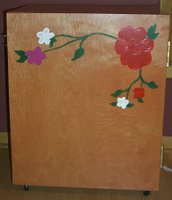We began homeschooling because my mother, a former public high school teacher, gave us a set of
Sing, Spell, Read, and Write books when my oldest daughter was 5. We hadn’t thought much about school at that point. We visited friends who homeschooled, and were impressed with their 7 year old daughter’s ability to read the Bible, even pronouncing all the Old Testament Hebrew names correctly. My wife was certified by the state to teach first through third grade, and we agreed in the beginning we would take homeschooling one year at a time, always evaluating at the end of each year whether to continue. When my oldest daughter turned 14, and high school loomed ahead, we took serious stock of what to do, knowing that our choice would affect our daughter’s future, and the ability to go to college. We prayed, worried, and agonized. We looked into all the private Christian schools in the area, examining curriculum, cost, and weighing the inconvenience of having to transport a child to school daily – we live out in the country on a mini-farm, seven miles from the nearest town. The curriculum at most of the Christian schools was not that different from the public school, and in many cases, was inferior.
The Christian schools cost about $5k per year on average, with the good ones costing $7,000 to $12,000, and being up to an hour’s drive away.
My wife is an excellent elementary school teacher, and handles with aplomb and patience the foibles and needs of teaching four children through the elementary and middle school years, with only the usual difficulties. But she isn’t able to teach high school math, chemistry, physics, and foreign language. It would be impossible with her work with the other children to stay even one lesson ahead in that many subjects. And I just don’t usually have time to teach more than one or two subjects regularly, due to the demands of my job. So what could we possibly do? I decided my daughter deserved the opportunity to help make the decision herself. She couldn’t make an informed decision without data, and never having been in a public school classroom, wouldn’t have the faintest idea what that was about. We arranged with the local high school for her to “shadow” another girl through her school day, and find out what going to public school would be like.
My daughter experienced first-hand the peer group nonsense that many teens go through, as the girl she was supposed to shadow ignored her and talked to her friends. The school requires all ninth graders to take a health class. As my daughter sat through this class, the teacher began explaining how homosexuality was a valid alternative lifestyle, and not a disease or in any way “bad”. It was all my daughter could do to keep from raising her hand and presenting the Biblical view of homosexuality, together with AIDS statistics. Needless to say, after her day at the school, we felt renewed purpose in finding a homeschool solution. We had tried A Beka Academy* when our second child was born, but found that the video school was set up as a classroom, with the usual busy work and disadvantages of a classroom. However, we just couldn’t find much else at the time, and so enrolled our daughter in Abeka video school for 9th grade.
It was an adjustment for her, with the work coming in higher volumes than she was used to. The highly structured approach was an adjustment for my wife as well – but it allowed my daughter to have daily instruction from a Christian perspective by qualified teachers, and to function more or less independently. We followed this with 10th grade, and then my daughter decided to attend community college for her last two years of high school. She just got her SAT scores back, and with these and two years at the community college, she’s quite likely to be accepted at a four year school, most likely Oregon State.
We’ve embarked on homeschooling our second daughter, Rebecca, through high school, this time using Bob Jones Homesat*, which affords some greater flexibility and a better math and science curriculum. There are so many choices available now for doing high school at home, secular and Christian. Many Universities, like University of Nebraska, University of Pennsylvania, Oregon State, and others are offering online classes for high schoolers, most fully accredited, and some offering full diploma programs. The number of Christian curriculums that go through high school has exploded.
In short, I offer encouragement to those whose children are about to enter high school – you CAN homeschool successfully, and it is not a barrier to entering college. (Michael from OR)
Note from the Webmaster: We welcome submissions from all homeschoolers and very much appreciate Michael's ideas and encouragement. I would like to caution, however, that A Beka and Bob Jones University Press both have some materials with bias against the Catholic Church. Bob Jones has an especially strong slant and has dozens of articles against Catholicism on its website. Further information on some of these issues can be found here:
catholic.com)






